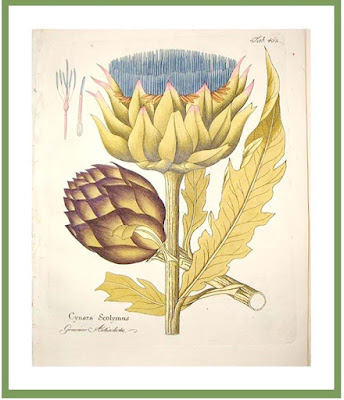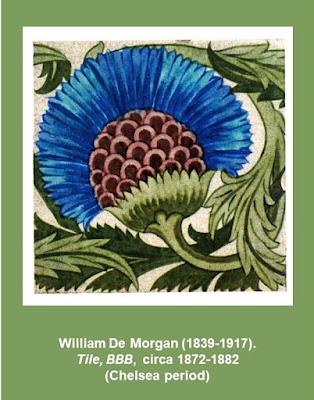Artichokes turn up in art a surprising number of times. Were the artists fascinated by the globe artichoke’s shape? The plant’s elaborate leaves doubtless appealed, too.
The botanical artichoke
Above: Ferdinand Bernhard Vietz (1772-1815). “Cynara cardunculus var. scolymus”. Hand-coloured engraving, Icones Plantarum Medico-Oeconomico-Technologicarum, 1800-1822.
The painted artichoke
Still life – 17th century
Above: Clara Peeters (1594-). “Still Life with Cheeses, Artichoke, and Cherries”. Oil on panel, circa 1625.
Above: Artist Unknown. “Still life with Artichokes, Lemons and Asparagus”. Oil on canvas, circa 1640. (Thought to be Spanish.)
Still life – 18th century
Above: Luis Egidio Meléndez (1716-1780). “Still Life of Artichokes and Tomatoes in a Landscape”. Oil on canvas, circa 1771-1774.
Still life – 20th century
Domestic interior – 18th century
Above: Antoine Raspal (1738-1811). “Intérieur de cuisine Provençale”. Oil on canvas, circa 1776-80.
(Used as the cover for Jane Grigson's Vegetable Book. Penguin, 1980)
Affordable artichokes to hang on the wall
Artichoke lithographic print
Artichoke wallpaper
Solider artichokes…
Above: “Basin with Hare and Artichoke”. Maiolica, circa 1450.
(Photo: Valerie McGlinchey, CC BY-SA 2.0 uk),
https://commons.wikimedia.org/w/index.php?curid=9977573
Above: Gaspard Robert (1722-1799). “Saucière avec plateau représentant un artichaut”. Polychrome petit feu decoration, [n.d.]
(Photo: Robert Valette, CC BY-SA 3.0)
https://commons.wikimedia.org/w/index.php?curid=3703144
Above: Chelsea (Porcelain Manufactory). “Artichoke Tureens and Covers”. Soft-paste porcelain, circa 1754-1755.
(Photo: Daderot)
https://commons.wikimedia.org/w/index.php?curid=37973034
https://commons.wikimedia.org/w/index.php?curid=37973037
Sometimes identified as a sunflower, when it’s reproduced in blue shades this William De Morgan tile is far more like an artichoke: the flower head’s rounded “petals” are exactly the same as those he uses in other artichoke designs. The tile is still produced today, though the modern versions I’ve seen online are not as attractive as this early hand-painted one. It is typically used sideways and exists today in two versions, one with the flower head facing left, the other facing right.
… What and why?
To end with, here’s a funny old model of an artichoke that I really like. Shaped and coloured fruits and vegetables such as this artichoke seem to have been immensely popular in America before the Second World War. You often see them on the auction listings and they are always described as “stone”. (This is not the same as “American Stoneware”, which consists of pots categorised as “crocks” fired at a high temperature and glazed in simple, subfusc shades.) I haven’t been able to find out what the stone fruits and vegetables are really made of—whether it is really is stone or some sort of china clay such as “stoneware”—or how they were used. They are clearly decorative articles and some of the pictures on a couple of Pinterest listings show brightly coloured examples, but details are never given. If you’ve got more information I’d love to see it! Email me at: katywiddop@gmail.com














